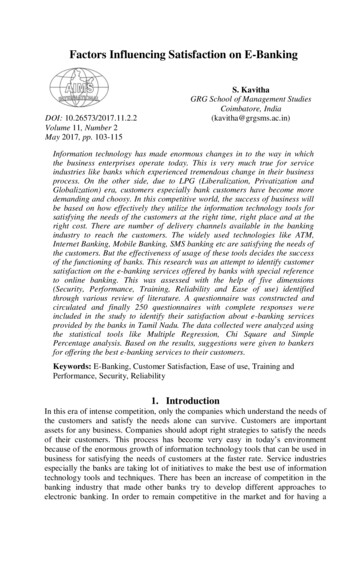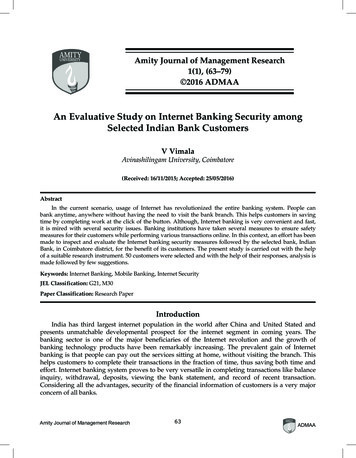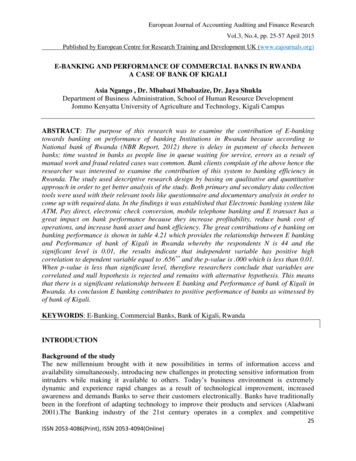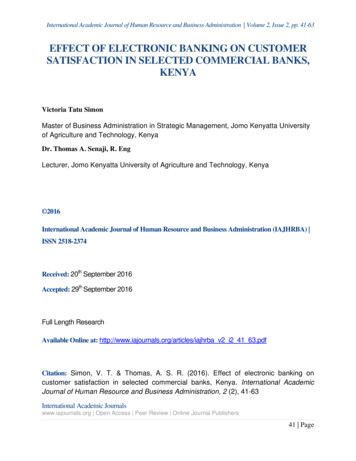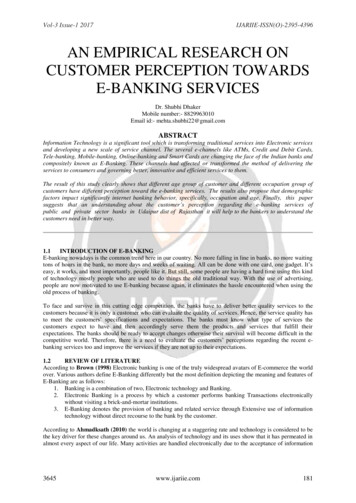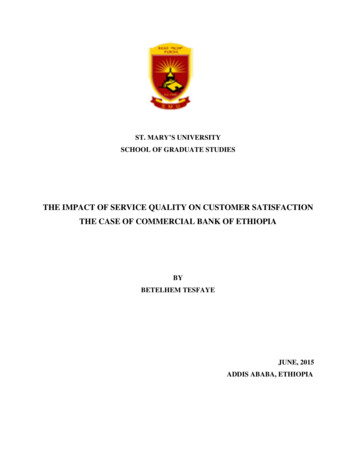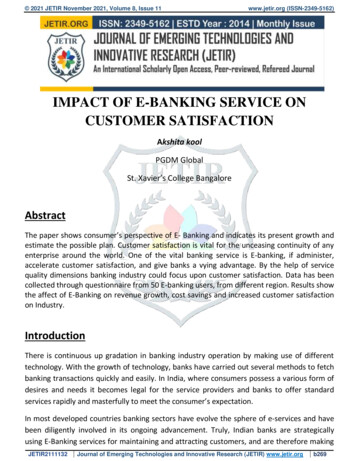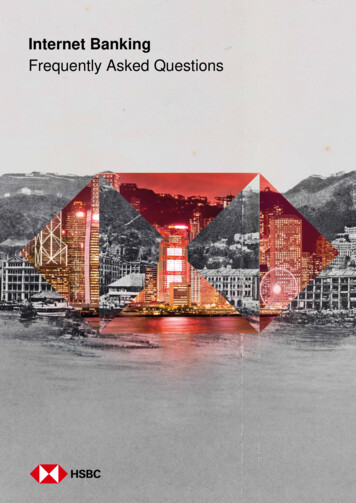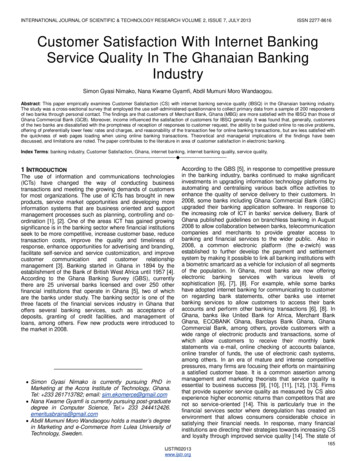
Transcription
INTERNATIONAL JOURNAL OF SCIENTIFIC & TECHNOLOGY RESEARCH VOLUME 2, ISSUE 7, JULY 2013ISSN 2277-8616Customer Satisfaction With Internet BankingService Quality In The Ghanaian BankingIndustrySimon Gyasi Nimako, Nana Kwame Gyamfi, Abdil Mumuni Moro Wandaogou.Abstract: This paper empirically examines Customer Satisfaction (CS) with internet banking service quality (IBSQ) in the Ghanaian banking industry.The study was a cross-sectional survey that employed the use self-administered questionnaire to collect primary data from a sample of 200 respondentsof two banks through personal contact. The findings are that customers of Merchant Bank, Ghana (MBG) are more satisfied with the IBSQ than those ofGhana Commercial Bank (GCB). Moreover, income influenced the satisfaction of customers for IBSQ generally. It was found that, generally, customersof the two banks are dissatisfied with the promptness of reception of responses to customer request, the ability to be guided online to res olve problems,offering of preferentially lower fees/ rates and charges, and reasonability of the transaction fee for online banking transactions, but are less satisfied withthe quickness of web pages loading when using online banking transactions. Theoretical and managerial implications of the findings have beendiscussed, and limitations are noted. The paper contributes to the literature in area of customer satisfaction in electronic banking.Index Terms: banking industry, Customer Satisfaction, Ghana, internet banking, internet banking quality, service quality,—————————— ——————————1 INTRODUCTIONThe use of information and communications technologies(ICTs) have changed the way of conducting businesstransactions and meeting the growing demands of customersfor most organizations. The use of ICTs has brought in newproducts, service market opportunities and developing moreinformation systems that are business oriented and supportmanagement processes such as planning, controlling and coordination [1], [2]. One of the areas ICT has gained growingsignificance is in the banking sector where financial institutionsseek to be more competitive, increase customer base, reducetransaction costs, improve the quality and timeliness ofresponse, enhance opportunities for advertising and branding,facilitate self-service and service customization, and improvecustomer communication and customer relationshipmanagement [3]. Banking started in Ghana in 1894 by theestablishment of the Bank of British West Africa until 1957 [4].According to the Ghana Banking Survey (GBS), currentlythere are 25 universal banks licensed and over 250 otherfinancial institutions that operate in Ghana [5], two of whichare the banks under study. The banking sector is one of thethree facets of the financial services industry in Ghana thatoffers several banking services, such as acceptance ofdeposits, granting of credit facilities, and management ofloans, among others. Few new products were introduced tothe market in — Simon Gyasi Nimako is currently pursuing PhD inMarketing at the Accra Institute of Technology, Ghana.Tel: 233 261713782; email: sim.ekomerce@gmail.com Nana Kwame Gyamfi is currently pursuing post-graduatedegree in Computer Science, Tel: 233 244412426.emeritusbrains@gmail.com Abdil Mumuni Moro Wandaogou holds a master’s degreein Marketing and e-Commerce from Lulea University ofTechnology, Sweden.According to the GBS [5], in response to competitive pressurein the banking industry, banks continued to make significantinvestments in upgrading information technology platforms byautomating and centralising various back office activities toenhance the quality of service delivery to their customers. In2008, some banks including Ghana Commercial Bank (GBC)upgraded their banking application software. In response tothe increasing role of ICT in banks‘ service delivery, Bank ofGhana published guidelines on branchless banking in August2008 to allow collaboration between banks, telecommunicationcompanies and merchants to provide greater access tobanking and financial services to the wider public. Also in2008, a common electronic platform (the e-zwich) wasestablished to further develop the payment and settlementsystem by making it possible to link all banking institutions witha biometric smartcard as a vehicle for inclusion of all segmentsof the population. In Ghana, most banks are now offeringelectronic banking services with various levels ofsophistication [6], [7], [8]. For example, while some bankshave adopted internet banking for communicating to customeron regarding bank statements, other banks use internetbanking services to allow customers to access their bankaccounts and perform other banking transactions [6], [8]. InGhana, banks like United Bank for Africa, Merchant BankGhana, ECOBANK Ghana, Barclays Bank Ghana, GhanaCommercial Bank, among others, provide customers with awide range of electronic products and transactions, some ofwhich allow customers to receive their monthly bankstatements via e-mail, online checking of accounts balance,online transfer of funds, the use of electronic cash systems,among others. In an era of mature and intense competitivepressures, many firms are focusing their efforts on maintaininga satisfied customer base. It is a common assertion amongmanagement and marketing theorists that service quality isessential to business success [9], [10], [11], [12], [13]. Firmsthat provide superior service quality as measured by CS alsoexperience higher economic returns than competitors that arenot so service-oriented [14]. This is particularly true in thefinancial services sector where deregulation has created anenvironment that allows consumers considerable choice insatisfying their financial needs. In response, many financialinstitutions are directing their strategies towards increasing CSand loyalty through improved service quality [14]. The state of165IJSTR 2013www.ijstr.org
INTERNATIONAL JOURNAL OF SCIENTIFIC & TECHNOLOGY RESEARCH VOLUME 2, ISSUE 7, JULY 2013CS with internet banking service quality has not receivedmuch attention in the literature. In recent times many ofstudies have looked at CS with IBSQ in different industrycontext in different countries [15], [16], [17], [18], [19], [20],[21], [22]m [23], [24]. With the exception of few studiesconducted in electronic banking context in Ghana [6], [8], thereis very limited empirical work in the area of customersatisfaction in the banking industry in general and in theinternet banking service quality (IBSQ) in Ghana in particular.Therefore, there is the need to examine CS in internet bankingindustry in Ghana in order to provide feedback to managementfor effective management strategy and to contribute to theliterature by furthering our understanding of the state of CS indeveloping country, Sub-Sahara Africa context. This coulddrive more research work in future in this area. Therefore, themain question of this study is: How satisfied are customerswith the internet banking service quality in Ghanaian bankingindustry (GBI)? The main purpose of this study is to evaluateCS with internet banking service quality in Ghanaian bankingindustry, using the cases of Ghana Commercial Bank (GCB)and Merchant Bank of Ghana (MBG). Specifically, theobjectives for this paper are:1. To evaluate customer satisfaction/dissatisfaction ofinternet banking service quality in Ghana CommercialBank and Merchant Bank of Ghana.2.To determine whether satisfaction ratings with internetbanking service quality are influenced by customerdemographic variables (Gender, age, education,income and marital status).2 LITERATURE REVIEW AND CONCEPTUAL FRAMEWORK2.1 Internet Banking Service Quality (IBSQ)Internet banking could be conceptualized within the context ofelectronic banking. Though it has been variously defined,according to [17], electronic banking is the delivery of banks‘information and services by banks to customers via differentdelivery platforms that can be used with different terminaldevices such as personal computer and mobile phone withbrowser or desktop software, telephone or digital television.Electronic banking, therefore, could be categorized into PCbanking, Internet banking, TV-based banking, and Telephonebased banking. It is a construct that consists of severaldistribution channels. Internet banking is the situation where―customers can access their bank account via the internetusing a PC or mobile phone and web-browser‖ [25, p. 2].Many past studies have developed various models forunderstanding relevant e-service quality dimensions relevantto internet banking. Joseph et al. [26] propose six onvenience/accuracy, feedback/complaint yandcustomization. Zeithaml et al. [27] contend that attributes ofinternet service quality include: access, ease of navigation,efficiency, flexibility, reliability, personalization, security,responsiveness, assurance, site aesthetics and priceknowledge. Jun and Cai [22], in a study of online banking,found that web site design, information, ease of use, access,courtesy, responsiveness, and reliability are significantdimensions that determine service quality. Yoo and Donthu[23] propose four dimensions, termed SITEQUAL, that includeease of use, aesthetics design, processing speed and security.ISSN 2277-8616The empirical work of [24] was conducted in an emergingeconomy of Taiwan Internet banking sector, they developedand validated a five dimension internet banking service qualitymodel that has 17-item measurement scale for measuring theservice quality in internet banking. The dimensions werebased on e-service quality model of [16]. The emergeddimensions for the internet banking service quality context are:web design, customer service, assurance, preferentialtreatment and information provision. First is Web design: Thisdimension covers the design of the web site and includesitems like web content layout, content updating, navigability,and user-friendliness. These are consistent with findings ofprevious studies [29], [30], [31]. Second is Customer Service:Customer service has been recognized as an importantelement for enhancing service quality in online shopping andbanking [28]. Elements in customer service dimension havebeen noted in many previous studies [32], [33]. This dimensionhas to do with service reliability, customer sensitivity,personalized service, and fast response to complaints thathave been described as responsiveness to customer needsand complaints [34]. Third is Assurance: many previous havedemonstrated that assurance is one of the critical elements ofonline banking service quality [23], [33]. The assurancedimension describes impressions by the service providers thatconvey a sense of security and credibility [34]. Security andprivacy are related items that affect the confidence to adoptonline banking services [35]. Fourth is Preferential treatment:This is related to the added value of using internet bankingservices. Where customers perceive that the incentive ofonline banking is attractive then they would be more willing touse internet banking. Fifth is Information provision:Information provision has become one of the key elements ofonline service quality as customer would need the rightinformation that enables them complete online bankingtransactions successfully [36]. In this study, internet bankingservice quality is, thus, conceptualized as a construct with fivedimensions that were identified in the empirical work of [36].2.2 Customer Satisfaction (CS)CS has become a major area of marketing that has receivedconsiderable publications from practitioners and scholars inthe last two decades. ―Satisfaction is a person‘s feeling ofpleasure or disappointment resulting from comparing aproduct‘s performance (outcome) in relation to his or herexpectation.‖ [37 p.144]. CS has been recognized as animportant element that drives customer retention, loyalty andpost-purchase behavior of customers [9], [37], [38]. It is welldocumented that the measurement of CS regarding theservice quality of firms is a necessary means by whichorganizations delve into the minds of its customers for usefulfeedback that could form the basis for effective marketingstrategy [37], [39], [40]. Since firms exist to satisfy customersby meeting their requirements, it is crucial for banks that offerinternet banking services to periodically and consistentlymeasure the satisfaction of their customers. As customers usethe banking internet services, it might be that they are notsatisfied, to some extent, with certain dimensions of theservice quality. For this reason this study examines CS withvarious service quality dimensions. While some authorsperceive satisfaction as a cumulative and others view it astransactional. Transactional-specific perspective, CS is basedon a one time, specific post-purchase evaluative judgement ofa service encounter [41]. On the other hand, in the cumulative166IJSTR 2013www.ijstr.org
INTERNATIONAL JOURNAL OF SCIENTIFIC & TECHNOLOGY RESEARCH VOLUME 2, ISSUE 7, JULY 2013CS perspective, CS is conceptualised as an overall customerevaluation of a product or service based on purchase andconsumption experiences over a time period [42]. It is arguedthat since cumulative satisfaction is based on a series ofpurchase and consumption experiences, it is more useful andreliable as a diagnostic and predictive tool than the transactionperspective that is based on a one-time purchase andconsumption experience. Therefore, the study conceptualisesCS as cumulative measured from the last twelve months ofbeing an internet banking customer. Danaher and Haddrell[43] studied a comparison of several scales simultaneously onthe same respondents. They concluded that thedisconfirmation scale is a preferred method in measuring CS,and that a five-point disconfirmation scale would be animprovement over the three-point scale if high predictivevalidity is essential. They however noted that one setback ofthe five-point disconfirmation scale could be its use intelephone surveys, where respondents might have to becontinually reminded of five rather than three scale points. Inthis study, since personal contact was to be used and highpredictive validity was a major concern, a five-pointdisconfirmation scale was adopted from much better expectedto much worse than expected. Therefore, overall CS and CSwith various dimensions of internet banking service qualitywould be measured using five-point disconfirmation scales.2.3 Conceptual Framework for the StudyIn this study, based on a thorough review of literature, theconceptual model presented in Figure 1. It depicts thedimensions of IBSQ for which CS was measured. Theconceptual framework for this study adopts the IBSQdimensions proposed in the model of IBSQ in [24].Customer serviceWeb designSatisfactionAssurancePreferential treatmentInformation provisionFig. 4 Conceptual Framework for the studyThis model was adopted for three reasons. First, the modelwas based on extensive literature review. Second, it wasbased on research in an emerging economy context, which issimilar to the emerging economy of Ghana. Third, thedimensions in the model are validated empirically asapplicable to internet banking context and not just general eservice quality context.ISSN 2277-86163 METHODOLOGY3.2 Population and Research contextThe target population consists of internet banking customersof GCB and MBG who have used internet banking for at leastthe past twelve months. The Merchant Bank Ghana Limited(MBG) is a universal Bank in Ghana that is committed toproviding quality financial products and services to theircustomers across their chosen market and maintaining theirplace as a leading and preferred financial institution in Ghana.The Bank provides a comprehensive range of bankingservices to its customers and clients, using its worldwidenetwork of correspondent banks and their agencies. The rangeof MBG's banking services includes: Domestic andInternational Banking Operations for Corporate Customers,Small & Medium Enterprises (SMEs) and, High Net-worthIndividuals; Treasury Services, Money and Capital MarketOperations, Hire Purchase and Leasing Services; and ForeignRemittances. Ghana Commercial Bank Ltd. (GCB) started in1953 as the Bank of the Gold Coast to provide bankingservices to the emerging nation for socio-economicdevelopment. The Bank was to provide special attention toGhanaian traders, business people and farmers who could notelicit support from the expatriate banks. In 1957, when Ghanaattained independence, Bank of Ghana was established as theCentral Bank while the Bank of the Gold Coast was renamedGhana Commercial Bank to focus solely on commercialbanking services. Since then GCB branches have beenopened across the length and breadth of the nation tappingthe potential of the 10 regions that make Ghana. GCBprovides a wide range of products and services for the benefitto its customers.From the traditional products of theCurrent/Savings Accounts, GCB now offers specializedproducts and services, loans and overdrafts, as well asinvestment products. GCB has taken advantage of anenhanced information technology system, to introduce InternetBanking (Commernet Plus), Royal Banking, Smart Pay (FeePayments), KudiNkosuo, GCB Inland Express Money Transfer,International Money Remittance Payments, GCBKidistarAccount and MasterCard. The main motivation for the choiceof GCB and MBG centers on their unique differences inoperational focus with similar internet banking platform. Thetwo banks are both government-owned banking institutionsthat have fundamentally different focus in banking. While GCBis mainly into tradition banking products (e.g. savings/currentaccount) with little aspect of investment banking service, MBGis typically into investment banking products (e.g.Funds/Portfolio Management, Money Market Operations,Investor Search & Joint Venture Arrangement) as well as otherspecialist services (e.g. Registrar Services, and CorporateFinance & Advisory Services). It would be interesting to studyhow these two are able to meet customers‘ needs and wantsthrough the use of internet banking platform and compare theresults for both managerial and theoretical implications.3.3 SamplingA convenient sample size of 200 respondents from eachcompany was used, 100 from each sub-group. In selecting the200 respondents, a purposive sampling method was used toconsciously select customers who meet the criteria of havingused internet banking services for the past twelve months.167IJSTR 2013www.ijstr.org
INTERNATIONAL JOURNAL OF SCIENTIFIC & TECHNOLOGY RESEARCH VOLUME 2, ISSUE 7, JULY 20133.4 Data Collection InstrumentA self-administered structured questionnaire was developedbased on the literature reviewed to gain insight into customers‘satisfaction with internet banking service quality in GCB andMBG. The self-administered questionnaire contained threesections. Section one contained bio data of respondents –gender, age, education, income and marital status. Sectiontwo focused on CS and section three contained mainly fivedimensions with 17 items for internet banking service qualitydimensions developed by Ho and Lin (2010). Overallsatisfaction with the internet banking service quality wasmeasured by asking respondents to rate their satisfaction withinternet banking service quality using a disconfirmation scale:Much worse than expected (1), worse than expected (2),equalto expectation (3), better than expected (4) and much betterthan expected (5). In all, (17) items asked about satisfactionwith five dimensions of internet banking service qualityadapted from Ho and Lin (2010), and were asked to rate theiroverall CS with internet banking service quality. Five (5) itemsrelated to the respondents‘ characteristics in one section.Though items of the questionnaire had been pre-tested andvalidated in previous studies [16], [24], the Cronbach alphareliability value yielded a composite alpha of 0.880 for theentire scale. This value is above the recommended 0.70 [44],therefore, the items in the measurement scale are consideredto possess high-internal consistency and reliability.4 DATA ANALYSISData were analysed using SPSS 16.0 for windows. Given thatall parametric assumptions were met, One-Way ANOVA wasused to determine differences in satisfaction amongdemographic sub-groups while in the case of unmetparametric assumptions, Kruskal-Wallis ANOVA was used todetermine the differences in satisfaction with IBSQ betweenthe two banks. The following section and sub-sectionsexplains results of the data analysis beginning with therespondents‘ characteristics.4.1 Respondents’ CharacteristicsThe characteristics of the respondents, in terms of gender,51.8% of the respondents were males and 48.2% werefemales. 12.9% of the respondents were below 25 years and38.1% were between 25 and 35 years, and 30.2% between 36and 45 years respectively, while 16.5% and 2.2% werebetween 46 and 55 years and 56 years and aboverespectively. This implies that majority of them were in theeconomically active population (25 – 45 years). Allrespondents were educated with majority of them, 79.1%having tertiary education, while 7.9% had Senior High School(SHS) and 12.9% had post-SHS education. In terms ofmonthly income, few of them, 2.9% earned below GH 100,33.1% earned between GH 101 to 500, while 27.3% and18.7% earned between GH 501 to GH 1000 and GH 1001 –1500 respectively. 18% of them earned above GH 1500.64.7% of the respondents were married, 31.7% were singleand 3.6% had other marital status. Finally, 55% of therespondents belonged to GCB while the rest 44.6 belonged toMBGISSN 2277-8616gender, education and marital status. Specifically, according toincome groups, the results show that higher income groups whoearn monthly incomes above GH 500 and 1500 are moresatisfied than those in the lower income groups, below GH 500.4.3 Overall Satisfaction with IBSQ in GCB and MBGSince the scale response are categories in nature, a KruskalWallis one-way-analysis of variable was used to determinewhether any significant difference in the rating ofCS/dissatisfaction with the internet banking service quality(IBSQ) of the two banks. The results of the analysis aresummarized in Table 2. Table 2 indicates that, 10.4% of therespondents described their overall satisfaction with theinternet banking service quality for GCB as worse thanexpected, 63.6% of them rated their overall satisfaction asequal to expectation while 26.0% rated it as much better thanexpected. For MBG, Table 2 indicates that, 1.6% of therespondents described their overall satisfaction as muchworse than expected,11.3% rated it as worse than expected,58.1% rated it as equal to expectation, 19.4% rated it as betterthan expected, while 9.7% rated it as much better thanexpected. The table further indicates that with mean overallsatisfaction of 2.84 for GCB and 3.24 for MBG respectively,the chi-square value is 10.008 with degree of freedom of 1,which results in a smaller p-value of 0.002 that is lower thanthe significance level (p 0.05). The meaning of this is thatthere is a significant difference in the overall CS of the twobanks regarding their internet banking service quality.Therefore, using the significance of the means, it could bededuced with 95% confidence that customers of MBG aremore satisfied than those of GCB.4.4 Satisfaction with Dimensions of IBSQFor the purpose of describing CS for each dimension itemwithin and between the cases, ratings of much worse thanexpected (1) and worse than expected (2) are described asdissatisfaction, while ratings of equal to (3), better than (4) andmuch better than expected (5) are added and described assatisfaction.4.2 Influence of Demographic Variables on SatisfactionThe results in Table 1 indicate that, generally, differences insatisfaction of internet banking service quality significantly differsamong only income groups, but not significantly according to168IJSTR 2013www.ijstr.org
INTERNATIONAL JOURNAL OF SCIENTIFIC & TECHNOLOGY RESEARCH VOLUME 2, ISSUE 7, JULY 2013TABLE 1INFLUENCE OF DEMOGRAPHIC VARIABLES ON SATISFACTIONTABLE 2DIFFERENCES IN SATISFACTION IN GCB AND tionMuch worse thanexpectedWorse thanexpectedEqual toexpectationBetter thanexpectedMuch better geBelow 252.83325-353.11336-452.92946-553.08756 3.3330.8414ISSN 2277-86160.501TotalGCBMBGMean 2.84Mean --69.77710062100EducationSHS2.812Post are TestsPearson Chi-SquareLikelihood Ratio(Kruskal Wal. ANOVA)Note: *p 0.05Income (GH )Below 03.0773.400Marital statusMarried3.111Single2.863OtherNote: *p 0.051.92720.1502.8004.4.1 Within case analysis for GCBTable 3 shows the CS with IBSQ for GCB. For GCB, satisfactionwith ease of completing of online transactions (WD1) is could bedescribed as high since only 13% indicated that they were notsatisfied while the rest (87%) maintained that they are satisfied.For ease logging on bank‘s online portal (WD2), only 16.9%were dissatisfied the rest (83.1%) were satisfied, so satisfactioncould be described as high for this dimension. For ease ofunderstanding which button to be clicked for the next step(WD3), only 13% were dissatisfied while majority (87%) weresatisfied, so customers could be said to be more satisfied forthis item. Regarding, the ability of the internet portal in helpingcustomer to complete a transaction quickly (WD4) 22.10% ofcustomers were dissatisfied while 77.90% were satisfied,therefore customers appear to be more satisfied with thisdimension item than 6*0.002*0.002*For customer service factor (CS1), being sufficiency of and realtime financial information provided by the internet banking portalsite, 15.60% of the respondents were dissatisfied while 84.40%were satisfied, which could be described as high satisfaction forthis item. Regarding the validity of the hyperlinks on the bank'sportal (CS2), customers were more satisfied since only 11.70%of them were dissatisfied while 88.30% were satisfied. For thequickness of the Web page on bank's portal site loading (CS3),customers were more dissatisfied than satisfied since 78.00%were dissatisfied while only 22.00% were satisfied. For theability of the bank's banking portal to perform service correctly atthe first time (CS4), more customers were satisfied (81.80%)than dissatisfied (18.20%).For prompt reception of responses tocustomer request (CS5), customers were more dissatisfied(84.50%) than they were satisfied (15.50%). Then for the lastcustomer service factor, being the internet banking system‘sability to guide customer to resolve problems (CS6), morecustomers were dissatisfied (84.50%) than satisfied (15.50%).Regarding the assurance factor which is the reliability andcredibility of transactions on the banking portal (AS1) receivedless dissatisfaction rating (15.60%) thansatisfactionrating(84.40%). For protection/security of customer transaction databy the banking portal site (AS2), more of the customers weresatisfied (92.20%) than dissatisfied (7.80%). For AS3, which isfeeling of relief of customer to transact on internet banking,more customers were satisfied (98.70%) than dissatisfied(1.30%).169IJSTR 2013www.ijstr.org
INTERNATIONAL JOURNAL OF SCIENTIFIC & TECHNOLOGY RESEARCH VOLUME 2, ISSUE 7, JULY 2013TABLE 3SATISFACTION WITH IBSQ IN GCBn 77Code Internet Banking Service QualityDissat.Sat.RemarkWeb designWD1 Easy completion of onlinetransactions.WD2 Easy logging on online portal.WD3 Easy understanding which button tobe clicked for the next step.WD4 Helping customer to complete atransaction quickly.13%87%Moresatisfied16.90% 83.10% Moresatisfied13%87%Moresatisfied22.10% 77.90% MoresatisfiedCustomer serviceCS1Sufficient and real time financialinformation provided.15.60% 84.40% MoresatisfiedCS2Validity of the hyperlinks on thebank's portal.11.70% 88.30% MoresatisfiedCS3Quickness of the Web page onbank's portal site loading.78.00% 22.00% NotsatisfiedCS4Banking portal to perform servicecorrectly at the first time.18.20% 81.80% MoresatisfiedCS5Prompt reception of responses tocustomer request.84.50% 15.50% NotsatisfiedCS6ability to guide customer to resolveproblems84.50% 15.50% NotsatisfiedAssuranceISSN 2277-8616the bank (IP2), customer were more satisfied (97.40% and98.70% respectively) than dissatisfied (2.60%and 1.30%)respectively. Significantly, it could be deduced from thediscussion summarized in Table 8 that, out of the 17 dimensionitems, more customers of GCB were dissatisfied with fivedimension items while most of the respondents are satisfiedwith the rest of the 12 dimension items. Out of the fivedimension items that customers are dissatisfied, three arerelated to customer service:1. Quickness of the Web page on bank's portal site loading;2.Prompt reception of responses to customer request;3.Internet banking system‘s ability to guide customer toresolve problems;And two are related to the two items of preferential treatment:1. Offering preferentially lower fees/ rates and charges2.Reasonability of the transaction fee for this bankingportal site.4.4.2 Within case analysis for MBGTable 4 shows the CS with IBSQ for MBG. For MBG, for all the17-dimension items, most customers were satisfied thandissatisfied. However, for five dimension items, between 30%and 40% of customers were dissatisfied, which needs to benoted by management of the bank. These five dimensionsincluded three items related to customer service, which are:1. Quickness of the Web page on bank's portal site loading;2.Prompt reception of responses to customer request;3.Internet banking system‘s ability to guide customer toresolve problems;AS1 Reliability and credibility oft
Ghana, ECOBANK Ghana, Barclays Bank Ghana, Ghana Commercial Bank, among others, provide customers with a wide range of electronic products and transactions, some of which allow customers to receive their monthly bank statements via e-mail, online checking of accounts balance, online transfer of funds, the use of electronic cash systems, among others. In an era of mature and intense competitive .
